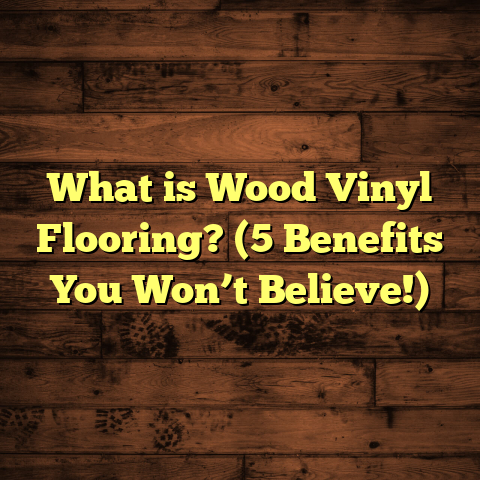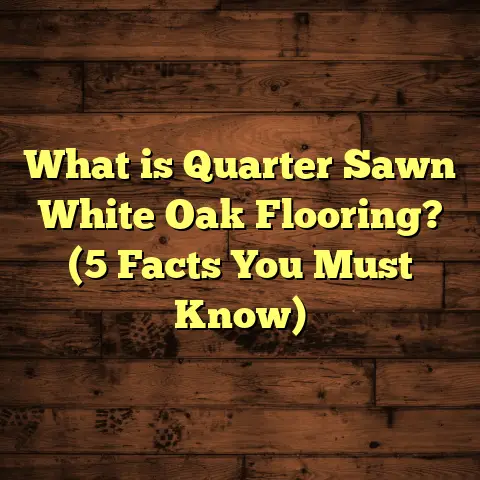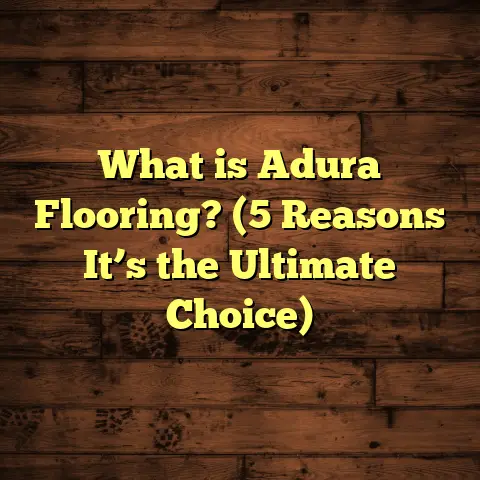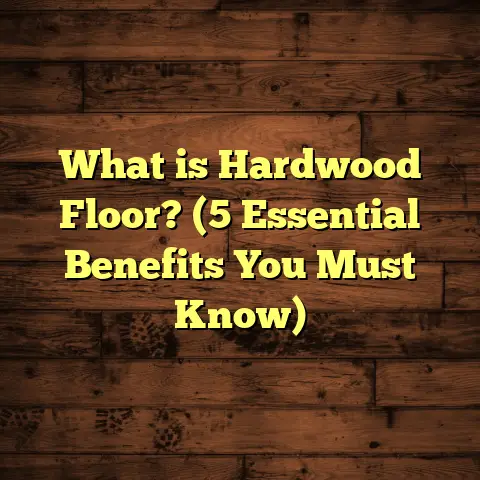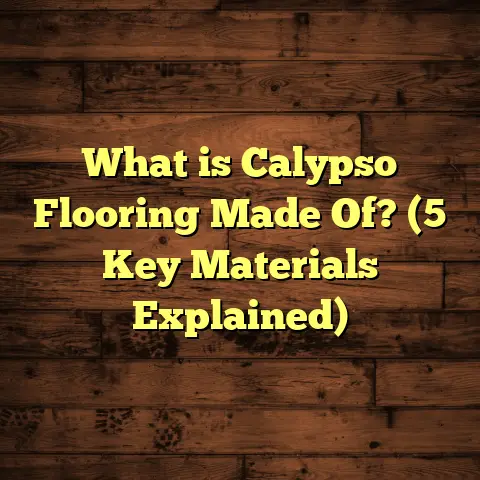What is Wood Plank Flooring? (5 Key Facts You Need)
I still remember the first time I stepped onto a freshly installed wood plank floor in a cozy cabin upstate. The warmth underfoot, the natural grain patterns swirling beneath my shoes—it was like the floor was telling a story, one that felt both timeless and personal. Since then, wood plank flooring has become one of my favorite topics to talk about, especially with friends who are thinking about giving their homes a fresh new look. But what exactly is wood plank flooring? And why does it seem to hold such a special place in so many homes?
I want to share everything I’ve learned after years of installing, repairing, and restoring wood plank floors—from the basics to the nitty-gritty details that can make a huge difference in your project’s success. Let’s get into it.
What is Wood Plank Flooring?
To put it simply:
Wood plank flooring consists of long, narrow strips of wood laid side by side to cover a floor surface.
These planks vary in width, length, and thickness but generally have consistent dimensions to fit neatly together. The key characteristic that sets wood plank flooring apart from other types of flooring is that each piece is a distinct length and width plank of wood, not smaller tiles or composite sheets.
But there’s more beneath the surface, literally and figuratively. Wood plank floors come in several varieties depending on how the wood is prepared and constructed. The two main types I deal with are:
- Solid Hardwood Planks: These are made from a single piece of solid wood, usually about 3/4 inch thick. They’re cut directly from logs and offer excellent durability and the ability to be sanded and refinished multiple times throughout their lifespan.
- Engineered Wood Planks: These consist of multiple layers of wood veneer glued together with a top hardwood layer. This construction makes engineered planks more stable with moisture fluctuations, so they can be installed in areas where solid hardwood might warp or swell.
When you first look at them, both types can appear very similar once finished with stains or sealants. But their structure affects how they perform over time, where they can be installed, and how they’re maintained.
The Anatomy of a Wood Plank
If you want to dive deeper into what makes up a wood plank floor:
- Face Layer (Top Layer): This is the visible hardwood surface, often 2-6 mm thick on engineered planks or the entire thickness on solid planks.
- Core Layers (Engineered Only): Multiple layers of plywood or high-density fiberboard beneath the face provide strength and help resist moisture.
- Backing Layer: Adds balance and stability to prevent warping.
- Tongue and Groove Edges: These interlock the planks together during installation for a seamless surface.
A good installer knows how to handle these components to ensure your floor looks beautiful and lasts for decades.
Five Key Facts You Need About Wood Plank Flooring
Now that you know what wood plank flooring is, let me share five key facts that I’ve learned from years in this business—facts that can save you time, money, and headaches when choosing or caring for your floors.
1. Natural Beauty That Ages Gracefully
There’s something magical about wood plank flooring aging over time.
Unlike synthetic floors that can wear out or look outdated fairly quickly, natural wood changes character as it ages. It develops a patina—a subtle sheen that adds depth—and small scratches or dents become part of its unique story rather than flaws.
When I restored an old Victorian home’s floors last year, I noticed how the original oak planks had darkened unevenly over 120 years. Instead of covering it up, we enhanced those variations with a light finish that brought out the grain’s beauty. The homeowners loved knowing their floors carried history beneath their feet.
According to the National Wood Flooring Association (NWFA), hardwood floors can last upwards of 75 years with proper care. That’s longer than most other flooring materials—even tile or vinyl—making wood a long-term investment for your home’s aesthetic and value.
Here’s something else you might find interesting: studies show that people feel warmer and more comfortable in rooms with natural wood floors. That tactile warmth isn’t just psychological—it comes from wood’s natural insulating properties and ability to regulate humidity.
2. Durability Depends on Wood Species and Plank Thickness
Not all wood species are equal in durability or appearance.
Hardwoods like:
- Oak
- Maple
- Hickory
- Walnut
are known for their strength and wear resistance. They’re great for high-traffic areas like living rooms or hallways. Oak is the most popular choice in the US because it balances hardness with beautiful grain patterns and affordability.
Softer woods like pine, cherry, or fir offer unique colors and rustic charm but are more prone to dents and scratches. That’s why they’re better suited for bedrooms or low-traffic spaces.
Thickness also matters a lot. Solid hardwood planks typically come around 3/4 inch thick, which allows for several rounds of sanding and refinishing during their life. Engineered planks have thinner face layers—sometimes as thin as 2 mm—but still offer decent durability if you choose high-quality products.
In one job I handled recently, the homeowners chose wide plank hickory flooring at 3/4 inch thickness for their entryway and kitchen. Despite heavy foot traffic and pet claws, the floors remained strong and beautiful after four years with only minor refinishing needed.
3. Installation Is Both an Art and a Science
Installing wood plank flooring isn’t just lining up boards and nailing them down. It requires skill, patience, and an understanding of how wood behaves.
One crucial step is acclimation—letting the wood planks sit in the room where they’ll be installed for at least 48 hours (sometimes longer) before installation. Wood expands and contracts based on humidity and temperature changes. Without acclimation, you risk gaps forming or boards buckling later.
I once helped a homeowner who skipped this step because they were eager to finish quickly. Within months, noticeable gaps appeared between boards during winter months when the air was drier inside their house.
Different installation methods include:
- Nail-down: Common for solid hardwood on wooden subfloors.
- Glue-down: Often used for engineered planks on concrete slabs.
- Floating floor: Planks lock together without being nailed or glued down; great for DIY projects or areas prone to moisture.
Choosing the right method depends on your subfloor type, room conditions, and budget.
4. Maintenance Requires Commitment but Pays Off
Wood plank floors don’t clean themselves—they need consistent care to stay looking their best. But trust me, it’s worth it.
Regularly sweeping or vacuuming removes dirt and grit that can scratch the surface. Using a damp mop with cleaners designed specifically for wood floors protects the finish without damaging it.
Avoid harsh chemicals or excessive water because moisture can warp wood over time.
Every 7-10 years (sometimes less in busy homes), refinishing breathes new life into your floors by sanding down surface scratches and applying fresh coats of finish.
I’ve seen families transform worn-out floors by refinishing them instead of replacing—a much more cost-effective and environmentally friendly option.
In my own home, I keep up with this routine religiously. After ten years, my oak plank floors still look like new thanks to regular cleaning and a couple of refinishing sessions.
5. Wood Plank Flooring Adds Value Beyond Aesthetics
One fact I love sharing with clients is how real wood flooring can boost home resale value.
Multiple real estate studies show hardwood floors can add between 2-5% to your home’s value compared to carpeted or laminate floors.
Buyers often associate wood floors with quality craftsmanship and style that synthetic alternatives just don’t offer.
In one renovation project I worked on, we installed wide plank oak flooring throughout the living areas. After listing their home, the owners received several offers above asking price—and many mentioned the floors specifically as a selling point.
So if you’re thinking about your next big home improvement project with an eye toward resale, investing in wood plank flooring makes financial sense along with aesthetic appeal.
Types of Wood Used for Plank Flooring: A Closer Look
Choosing what kind of wood you want probably feels overwhelming with so many options out there. Let me break down some popular species I’ve worked with:
| Wood Species | Hardness (Janka Rating) | Appearance | Best Uses | Cost Estimate per sq ft |
|---|---|---|---|---|
| Red Oak | 1290 | Warm reddish tones with prominent grain | Living rooms, hallways | $6 – $12 |
| White Oak | 1360 | Slightly paler than red oak with tighter grain | Kitchens, dining rooms | $7 – $13 |
| Maple | 1450 | Light cream color with subtle grain | Bedrooms, high-traffic areas | $7 – $14 |
| Hickory | 1820 | Varied tones from light to dark brown, dramatic grain | Entryways, kitchens | $8 – $15 |
| Walnut | 1010 | Rich chocolate brown with straight grain | Formal areas | $9 – $18 |
| Pine | 380 | Soft yellowish tones with knots for rustic look | Low traffic areas | $4 – $8 |
The Janka hardness rating measures how resistant a wood species is to denting and wear—the higher the number, the harder the wood.
In my experience discussing options with homeowners, pine appeals for its cozy rustic vibe but requires more care due to softness. Oak strikes a nice balance between durability and price for most families.
Engineered vs Solid Hardwood: Which Should You Choose?
Here’s something I get asked all the time:
“Should I go engineered or solid hardwood plank flooring?”
Both have benefits, so let me explain:
Solid Hardwood
- Made from one solid piece of wood.
- Can be sanded/refinished multiple times.
- Usually thicker (around 3/4 inch).
- Best installed on wooden subfloors.
- Susceptible to moisture changes; not ideal for basements or bathrooms.
- Classic choice for traditional homes.
- Typically more expensive upfront due to thickness/materials.
Engineered Hardwood
- Made of layered plywood core + hardwood veneer top layer.
- More stable in moisture-prone environments.
- Can be installed over concrete slabs.
- Allows floating installation method.
- Face layer thickness affects sanding/refinishing ability (thicker = more refinishing).
- Usually less expensive than solid hardwood but varies by brand/species.
- Can handle radiant floor heating better than solid wood.
For example, I helped a client install engineered oak planks in their basement family room where moisture would have ruined solid hardwood within months. The engineered floor stayed flawless after two winters.
If you want longevity plus flexibility in installation areas, engineered might be your best bet without sacrificing natural beauty.
How Wood Plank Flooring Influences Interior Design
Wood plank floors don’t just cover space; they set a tone for your entire room’s style.
Thinking about design? Here are some ways different choices affect your home’s vibe:
Wide vs Narrow Planks
Wider planks (5 inches or more) create a rustic or modern feel depending on finish—perfect for open-concept living areas where you want to highlight natural textures. Narrower planks (2-3 inches) lend themselves well to traditional or formal rooms because they add visual detail without overwhelming space.
Light vs Dark Stains
Light stains brighten rooms and enhance modern or Scandinavian aesthetics—great if you want airy spaces or have smaller rooms needing openness. Dark stains add drama and warmth but show dust/scratches more easily; they suit classic or cozy interiors well.
Matte vs Glossy Finishes
Matte finishes showcase natural texture without glare; I recommend these for homes wanting understated elegance or rustic appeal. High-gloss floors bring shine and reflect light—ideal if you want clean lines and a polished look but prepare for more maintenance to keep them pristine.
Real-life Case Study: A Family’s Journey Choosing Wood Plank Flooring
To help bring this all together, here’s a story from a family I worked with recently:
The Johnson family was renovating their 1920s bungalow near Portland. They wanted floors that matched the home’s character but could withstand kids running around and pets playing outside.
After discussing options, we settled on:
- Solid white oak planks,
- 4 inches wide,
- Medium matte finish,
- Nail-down installation on original wooden subfloor,
- Acclimated for 72 hours before install.
The results? Stunning natural warmth paired with durability they needed. Two years later, Mrs. Johnson told me how much they appreciated the floor’s resilience—minor scratches buffed out easily—and how guests always complimented their “timeless” flooring choice.
This project reinforced what I already knew: picking quality materials combined with proper installation pays dividends long term.
Budgeting Your Wood Plank Flooring Project
Let’s talk money—because that decision often drives everything else!
Typical costs depend on:
- Wood species
- Type (solid vs engineered)
- Plank width/thickness
- Installation method
- Region/labor rates
A quick breakdown:
| Category | Estimated Cost (per sq ft) |
|---|---|
| Solid Hardwood Material | $6 – $15 |
| Engineered Hardwood Material | $4 – $12 |
| Installation Labor | $3 – $8 |
| Additional Materials | Underlayment ($0.50-$1), Finishes ($1-$3) |
| Total | Around $10 – $25 |
I always advise clients to get multiple quotes but also consider long-term value over just upfront price. Cheaper materials might save you now but cost more in repairs or replacements later.
Using tools like FloorTally can help estimate costs based on local labor rates and material prices so you don’t get surprised halfway through your project.
Environmental Impact: Is Wood Flooring Sustainable?
Sustainability matters more than ever when choosing materials.
Wood plank flooring can be an eco-friendly choice if sourced responsibly:
- Look for certifications like FSC (Forest Stewardship Council) which ensure forests are managed sustainably.
- Engineered wood uses less hardwood per plank since only top veneer is solid wood.
- Wood is biodegradable compared to synthetic options.
- Long lifespan means less frequent replacement reducing waste overall.
I’ve encouraged many clients interested in green building to choose certified hardwoods combined with low-VOC finishes (low volatile organic compounds) to keep indoor air quality healthy too.
Common Issues With Wood Plank Flooring & How To Avoid Them
Even though I love working with wood floors, they’re not without challenges:
Gapping & Cupping
Changes in humidity cause expansion/contraction leading to gaps between boards or edges curling upwards (cupping).
Prevention: Proper acclimation before install + maintaining indoor humidity between 35%-55%.
Scratches & Dents
Wood can dent from heavy furniture or pet claws.
Tip: Use furniture pads + area rugs in high-use zones + regular refinishing as needed.
Moisture Damage
Water spills left unattended cause warping or stains.
Tip: Wipe spills quickly + avoid excessive water cleaning + use engineered planks in moisture-prone areas like basements/kitchens.
Fading From Sunlight
UV rays change color over time causing uneven fading.
Solution: Use window treatments + rotate area rugs occasionally + choose UV-resistant finishes if possible.
Comparing Wood Plank Flooring With Other Popular Flooring Solutions
Let me wrap things up by comparing wood plank flooring against other commonly chosen materials so you get a clearer picture:
| Feature | Wood Plank Flooring | Laminate Flooring | Vinyl Plank Flooring | Carpet | Tile |
|---|---|---|---|---|---|
| Durability | High (with maintenance) | Medium | Medium-high | Low | Very high |
| Maintenance | Moderate | Low | Low | High | Low |
| Installation | Skilled required | DIY-friendly | DIY-friendly | DIY-friendly | Professional recommended |
| Price Range | $$ – $$$ | $ – $$ | $ – $$ | $ – $$ | $$ – $$$ |
| Aesthetic Appeal | Natural warmth & character | Mimics wood but less authentic | Waterproof versatility | Softness & warmth | Durable & elegant |
| Lifespan | Decades | 10-20 years | 10-20 years | 5-10 years | Decades |
| Environmental Impact | Biodegradable if sourced well | Synthetic | Synthetic | Synthetic | Varies |
From what I’ve seen over thousands of square feet installed: if you want authentic natural beauty plus long-term value—and you’re willing to invest some effort in maintenance—wood plank flooring stands out as one of the best choices out there.
If you’re thinking about making this kind of upgrade in your home, feel free to ask me anything about selecting species, finishes, installation tips, or even budgeting strategies. After all these years working hands-on with wood floors in diverse environments—from rustic cabins to urban condos—I’m confident I can help you find what fits your lifestyle perfectly!
Would you like me to help you compare different types based on your specific room conditions? Just say the word!

